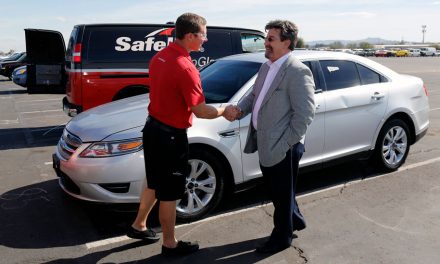
Avoiding a “GPS strategy”
Strategic prespectives from Mail & Express Review columnist Howard Wright, CEO of Insight2foresight. Planning or strategy?
The impact of the recent recession has not only been financial but it seems to have had a fundamental impact on business planning and strategy. There appears to be a shortening of the strategic planning horizon with companies now talking in terms of a few years for their strategy timelines. What used to be called a plan has now become a strategy!
Historically there was a clear order for the ‘planning’ process along with definitions of timescales. However, the disturbances in the business environment seem to have resulted in companies throwing away their traditional approach to long term strategic planning and instead focusing on the tactical, the short term. As a recent personal example, I had just given a presentation to a senior board member on the role of long-term visioning and strategy. His response was that if it was for a period of more than twelve weeks he was not interested. He then terminated the session. A clear indication that this company was not going to survive for long!
The result of this strategy myopia is that we seem to be disregarding any context for strategy and business cases, instead relying on the current environment and market conditions. Every business case is then seen in isolation and the result is that some of the decisions taken become disjointed and surprising.
Strategic Perspectives
There are many ways to look at what futures might unfold and to create and articulate those futures. For the purposes of this article they can be distilled into four broad categories: evidential forecasting or ‘looking back’; probabilistic forecasting which involves ‘seeing forward’; scenario forecasting or ‘creating alternative futures’; and lastly science fiction, ‘imagining new futures’. Each has its benefits and each its drawbacks.
Evidential Forecasting: This approach looks back at history and then, based on the current situation, uses this historic evidence to forecast what is going to happen next. This approach is favoured by large companies as it is relatively mechanical in nature. Risks can be assigned a value and set down in a spreadsheet.
The downside is that if you have never seen an event happen before, for example the last recession, the iPad or the nuclear power plant problems in Japan, it is hard to build it into your forecast. This type of forecast tends to be relatively short term: typically one to three years.
Probabilistic Forecasting: This technique takes the current state of play and overlays it with future presumed occurrences using these future events to influence the forecast. Examples of such presumed occurrences could be the Olympics, general elections, known technological implementations. Each is assigned a probability of occurrence as well as an impact on the business or market.
The downside of this approach is that you can only include things that you know about and for which you can gauge probability and impact. This technique can be good when planning for future implementations, staffing and similar resource based activities. This type of forecast tends to be relatively short term: typically three to five years.
Scenario Forecasting: Unlike the two previous techniques Scenario Forecasting looks at alternative futures and typically brings them to life through stories. Scenarios in the past have been used to highlight cultural and societal changes and have their roots in the storytelling of old. The level of detail in the scenarios can be highly detailed such as those undertaken by Shell, where complex algorithms are included in the scenarios to try and predict with a high level of granularity the impact of future events. Scenarios are often based on desired states as a way of stimulating debate and discussion rather than prediction.
The downside of this approach is that the scenarios can be seen as trivial and unrealistic, and not relevant to today’s business. However, they are extremely powerful at encouraging debate and discussion. This technique can be used for a wide range of ‘horizons’ but works well in a two to five year timescale.
Science Fiction: Although not exactly a technique the use of writings from science fiction writers can, and has, informed some of the technology we see around us today. For instance, William Gibson predicted the Internet in his book Neuromancer and Star Trek used the iPhone-like Tricorder. Indeed there are groups around the world that try and bring to life some of the science of science fiction.
The challenge for businesses is to find an acceptable way of using this approach in their forecasting. Certainly the style can be used effectively when writing scenarios. Clearly this is for distant futures and many of the books in the genre are set a century or more in the future. That said, the speed of technological development these days means a hundred years probably equates to one or two decades in reality.
Approaching the future
So how can you use these techniques to create the context that will allow you to take informed business decisions and not spend your time fire fighting and relying on the corporate GPS? As so often the vital first stage is to accept that there is a problem, that you do not have the context you require. Once you have accepted this it is time to think about how you want to approach the future. I have developed a simple five step approach which will at least get you started.
Set your horizons: It is important that you set a date that is far enough in the future so that today’s problems are no longer an issue. Looking at the various planning time horizons (one to two, three to five, five to ten) only the five to ten year horizon can be considered potentially visionary. However, talking to colleagues in strategy functions around the world reveals that the focus seems to be very much on a one-two year so-called vision, rather than any sort of far horizon.
Identify a context for the vision and strategy: This is one of the most important steps and one that is being overlooked. Having a ‘picture’ of the environment in the three time horizons will not only inform the strategy but also provide the necessary context for understanding the drivers and goals. This contextual view does not have to be detailed or even correct but is will serve the purpose of stimulating discussion and debate. It enables a shared understanding of the future.
Understand the macro trends: There needs to be a reasonably detailed understanding of the key macro trends and drivers both for the industry and for society as a whole. There may be things that will fundamentally change how people and businesses behave and without having this understanding business decisions can be made which in the cold light of deployment seem ill-advised. With typical large scale projects taking upwards of three years to fully deploy the world in which they have to exist can fundamentally change. An example taken from recent years is the dramatic move to mobile. Although this was seen in the late 1990’s many organisations were blindsided by its take up and had to quickly ‘cobble‘ together a response when it was clear that there was no going back.
View the future from different perspectives. Imagine a future that has been articulated from different perspectives: a customer, for example, a business, an employee, a shareholder, a board member, a child. How would these different elements respond to this ‘new’ future? What, if anything, would they do differently? We all tend to think that everyone thinks like we do, has had the same experience that we have had, and shares the same values and insights. The reality is that we all have a very different view of the world and by forcing yourself to adopt these different viewpoints you will hopefully challenge some of the pre-conceptions that you and the company have.
Articulate the vision: Use the macro trend information to inform and test the strategy. This is probably one of the most important steps. If you are unable to articulate the vision in a way that engages people and provides a believable context then it is probably not realistic.
Closing thoughts
Although this article is written in terms of company strategy, the simple five step approach can be used for individual projects and even at home when you are considering a major purchase or investment.
The need to try and understand changing business and societal environments is probably more important today than it has ever been, because we are seeing so much change, particularly driven by technology. Although it can be difficult to second guess the impact of these technologies that should not stop us from trying.
When building your wider context the reality is that you will probably get it wrong. Do not worry: the mere fact that you have written something down will bring it to front of mind.
This article was published in the June issue of Mail & Express Review. To subscribe to the magazine, click here.










